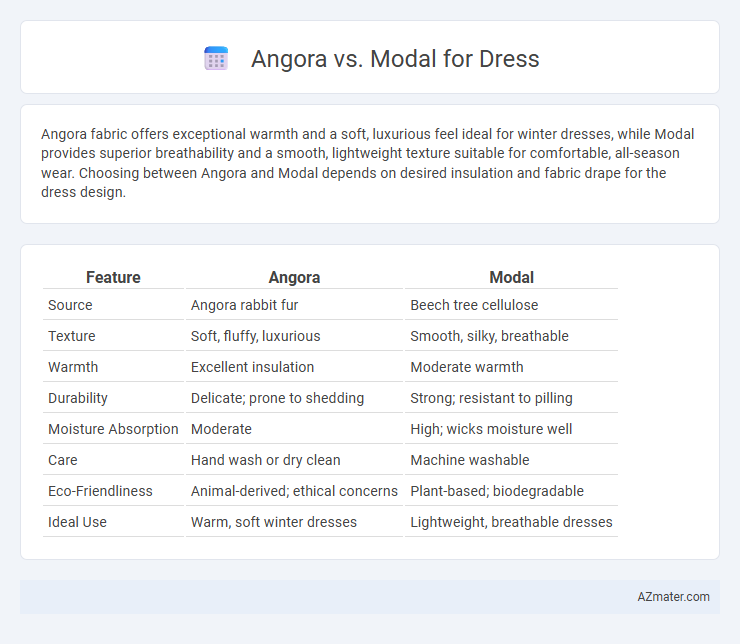Angora fabric offers exceptional warmth and a soft, luxurious feel ideal for winter dresses, while Modal provides superior breathability and a smooth, lightweight texture suitable for comfortable, all-season wear. Choosing between Angora and Modal depends on desired insulation and fabric drape for the dress design.
Table of Comparison
| Feature | Angora | Modal |
|---|---|---|
| Source | Angora rabbit fur | Beech tree cellulose |
| Texture | Soft, fluffy, luxurious | Smooth, silky, breathable |
| Warmth | Excellent insulation | Moderate warmth |
| Durability | Delicate; prone to shedding | Strong; resistant to pilling |
| Moisture Absorption | Moderate | High; wicks moisture well |
| Care | Hand wash or dry clean | Machine washable |
| Eco-Friendliness | Animal-derived; ethical concerns | Plant-based; biodegradable |
| Ideal Use | Warm, soft winter dresses | Lightweight, breathable dresses |
Introduction to Angora and Modal
Angora fabric, derived from the hair of Angora rabbits, is renowned for its exceptional softness, warmth, and luxurious texture, making it a premium choice for winter dresses. Modal, a semi-synthetic fabric made from beech tree pulp, offers breathability, moisture-wicking properties, and a smooth drape, ideal for lightweight, comfortable dresses suitable for warmer climates. Both fabrics excel in comfort and quality but serve distinct purposes depending on the desired dress style and seasonal wear.
Origin and Production Processes
Angora fibers are sourced from Angora rabbits, primarily raised in regions like Turkey, China, and France, known for their delicate and warm wool. Modal fibers originate from beech tree cellulose, produced through a semi-synthetic process involving the regeneration of natural fibers, mainly in countries such as Austria and India. The production of Angora requires meticulous hand-combing and spinning, while Modal involves chemical treatment and mechanical spinning to create a smooth, breathable fabric ideal for dresses.
Texture and Feel: Angora vs Modal
Angora fabric, derived from Angora rabbit fur, offers an exceptionally soft, fluffy texture that provides a luxurious, warm, and lightweight feel, making it ideal for cozy dresses. Modal, a semi-synthetic fiber made from beech tree pulp, features a smooth, silky texture with excellent breathability and moisture-wicking properties, resulting in a cool, soft, and drapey fabric perfect for flowy dresses. The key difference lies in Angora's plush warmth and loftiness, while Modal excels in smoothness and comfort with moisture management.
Breathability and Comfort Factors
Angora fabric offers excellent breathability due to its natural wool fibers, providing warmth without causing overheating, making it comfortable for cooler weather dresses. Modal, a semi-synthetic fiber derived from beech trees, boasts superior moisture-wicking properties that enhance breathability and keep the skin dry, ideal for warm climates. Both materials provide a soft texture, but modal's smooth and lightweight characteristics make it more comfortable for all-day wear in varied temperatures.
Durability and Longevity Comparison
Angora fibers offer exceptional softness but tend to be less durable than Modal, as Angora is prone to pilling and delicate wear over time. Modal fabric, made from beech tree cellulose, provides superior durability with high resistance to shrinkage and fading, ensuring longer-lasting dresses. Dresses crafted from Modal maintain their shape and color better after multiple washes, making them ideal for longevity compared to Angora-based garments.
Warmth and Seasonal Suitability
Angora fibers provide exceptional warmth due to their excellent insulation properties, making Angora dresses ideal for cold winter months and chilly environments. Modal fabric, while breathable and moisture-wicking, offers moderate warmth suitable for transitional seasons like spring and fall. Dresses made from Angora are best for retaining heat in colder climates, whereas Modal dresses are preferred for a lightweight, comfortable fit during milder temperatures.
Sustainability and Ethical Considerations
Angora fibers, sourced from Angora rabbits, raise significant ethical concerns due to animal welfare issues and the intensive farming practices involved, leading to growing calls for cruelty-free alternatives. Modal, a semi-synthetic fabric derived from sustainably managed beech tree pulp through eco-friendly processes, offers a biodegradable and lower-impact option for dress materials with strong environmental credentials. Brands prioritizing sustainability increasingly favor modal for its closed-loop production system and reduced water and chemical usage, making it a more ethical choice compared to conventional Angora.
Care and Maintenance Requirements
Angora dresses require gentle hand washing or dry cleaning to maintain their soft texture and prevent fiber damage, while Modal dresses are more durable and can typically be machine washed on a gentle cycle without losing shape. Angora fibers are delicate and prone to pilling, necessitating careful storage and avoidance of friction, whereas Modal is resistant to shrinking and wrinkling, making it easier to care for. Proper moisture control and avoiding heat exposure are crucial for Angora, while Modal's moisture-wicking properties enhance its low-maintenance appeal.
Price Differences and Value
Angora fabric typically commands a higher price than Modal due to its natural origin from Angora rabbit fibers and luxurious softness, which enhance warmth and comfort in dresses. Modal, a semi-synthetic fiber made from beech tree pulp, is generally more affordable and offers excellent breathability and durability, providing great value for budget-conscious consumers. While Angora delivers premium insulation and luxury, Modal balances cost-effectiveness with practical wearability, making the choice dependent on the desired mix of price and fabric performance in dresses.
Suitability for Different Dress Styles
Angora fabric offers exceptional warmth and a soft texture, making it ideal for winter dresses and formal wear that require a luxurious feel. Modal, known for its breathability and smooth drape, suits summer dresses and casual styles that prioritize comfort and fluidity. Selecting between Angora and Modal depends on the desired dress style and seasonal functionality, with Angora favored for structured, elegant outfits and Modal preferred for lightweight, flowy designs.

Infographic: Angora vs Modal for Dress
 azmater.com
azmater.com